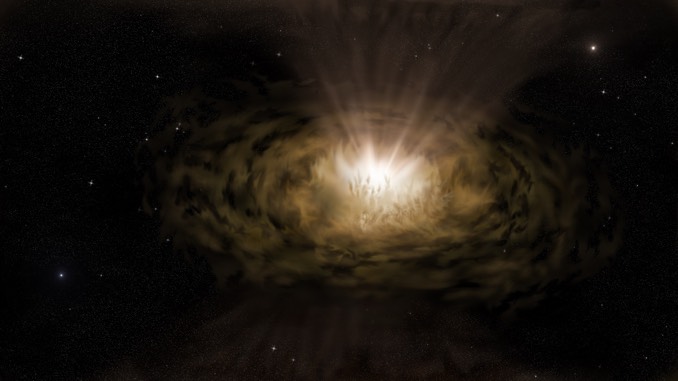
Complex changes in the light emitted from an active galactic nucleus, or AGN, where vast amounts of material are being sucked into a supermassive black hole, can be explained by relatively small clouds of dust that partially obscure the innermost regions, astronomers say.
In a paper published in the 14 June issue of Monthly Notices of the Royal Astronomical Society, astronomers at the University of California Santa Cruz report the development of computer code that allows them to carry out simulations that closely match AGN observations.
“We’ve shown that a lot of mysterious properties of active galactic nuclei can be explained by these small dusty clouds causing changes in what we see,” said Martin Gaskell, a research associate in astronomy and astrophysics and lead author of the Monthly Notices paper. “The emission from this gas is one of the best sources of information about the mass of a black hole and how it is growing. However, the nature of this gas is poorly understood.”
Gas spiralling in toward a black hole is heated to enormous temperatures as it forms a flat accretion disk, emitting high-energy radiation in a so-called broad-line region. Co-author Peter Harrington, a UCSC graduate student, said some of the light is absorbed and re-emitted by gases above and below the disk, which interacts with dust farther away.
“Once the dust crosses a certain threshold it is subjected to the strong radiation from the accretion disk,” said Harrington. “This radiation is so intense that it blows the dust away from the disk, resulting in a clumpy outflow of dust clouds starting at the outer edge of the broad-line region.”
The dust clouds dim and redden the light emitted from the broad-line region, the astronomers conclude.
“We’ve written the code so we can adjust parameters like the distribution of gas in the broad-line region, how fast it’s moving, and the orientation of the system, and then we can introduce dust clouds and see how they affect the emission-line profiles,” Harrington said.
By including dust clouds in their model, Gaskell and Harrington can replicate many of the observed features of AGN emissions, eliminating the need for more exotic explanations such as binary black holes.
Says Gaskell: “Our explanation lets us retain the simplicity of the standard AGN model of matter spiralling onto a single black hole.”



